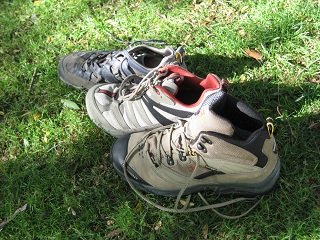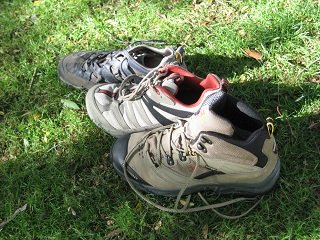 As I’ve said in previous articles, gearing up for a new interest in hiking starts from the ground up. This, of course, means finding a quality pair of hiking boots that not only suit your level of activity and terrain, but are comfortable and protect your feet from harm. Today’s article is the first of two that will break down some of the individual characteristics of hiking boots. The cut, or length, of a boot is an important factor to consider when choosing a pair that’s right for you, and today I’ll illustrate the benefits of the different boot cuts on the market in order to help readers gain a better understanding of the different options available to them.
As I’ve said in previous articles, gearing up for a new interest in hiking starts from the ground up. This, of course, means finding a quality pair of hiking boots that not only suit your level of activity and terrain, but are comfortable and protect your feet from harm. Today’s article is the first of two that will break down some of the individual characteristics of hiking boots. The cut, or length, of a boot is an important factor to consider when choosing a pair that’s right for you, and today I’ll illustrate the benefits of the different boot cuts on the market in order to help readers gain a better understanding of the different options available to them.
Hiking boots vary size and shape, but all styles fall into either one of three categories of length: low, mid, and high. Low-cut models are designed for more casual hikes and walks, and are usually limited to areas like parks or well-maintained trails, where brisk walks last around an hour or less. This style is also designed for lightweight travel, which means they’re not made to provide comfort or support when carrying heavier loads, like a full backpack. The lower cut doesn’t provide a lot of roll resistance for your ankles, and also leaves your ankle and lower leg more vulnerable to low branches, thorns, poisonous plants, and water or mud. Go with a low-cut boot if you’re looking for durable footwear for brisk afternoon walks or the occasional brisk day hike at your local park, but if you think you’ll be doing more serious hiking, leave this style on the shelf.
Mid-cut boots offer a little more ankle protection than low-cut boots, which will help keep them safer from debris and environmental inconveniences like puddles. Most mid-cut boot models also implement materials designed to increase comfort during longer treks or when you’re carrying a heavier load.
Lastly, high-cut models offer enhanced balance, ankle support, and durability for hikes of any length, and are designed to withstand very heavy loads. The higher length also means better protection for your ankles on uneven or slippery terrain, as well as from snow, water, and mud. Most high-cut boots will require a bit of breaking in before a long trip, however, as the upper portion might be a little stiff at first.
As always, consider your experience, your anticipated level of activity, and your price range before making a decision. Try on both boots at the store and walk around for a bit, as well. Also, if possible, try to load one of the store’s display backpacks with some weight (some stores will do this for you with actual weights), in order to get a true feel for what the boots will feel like with such a load, especially if you plan on going on multi-day hikes with a full pack. The cut of a boot is a very important factor in your purchase, and the right length will make all the difference when you’re hiking. Be sure to check out the second part of the Anatomy of a Hiking Boot series, where I’ll describe some of the different materials commonly found in hiking boots.








